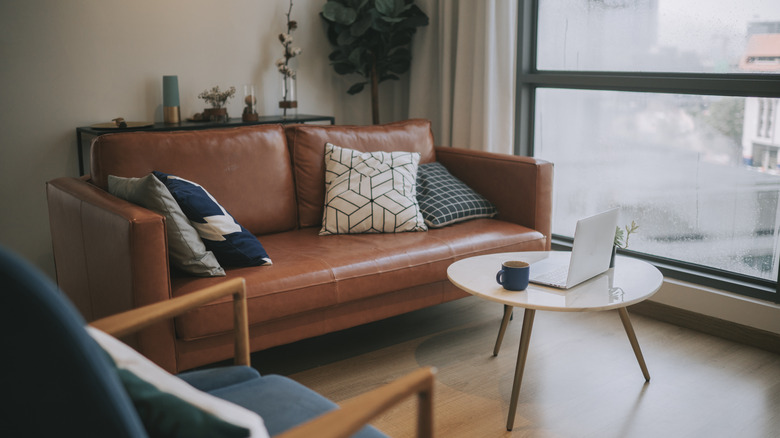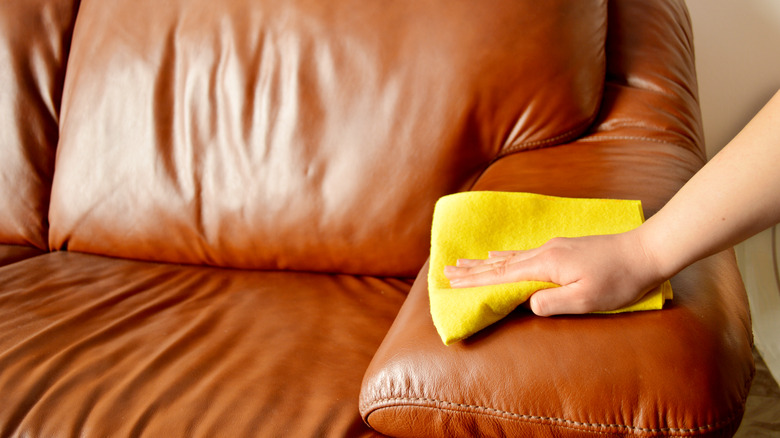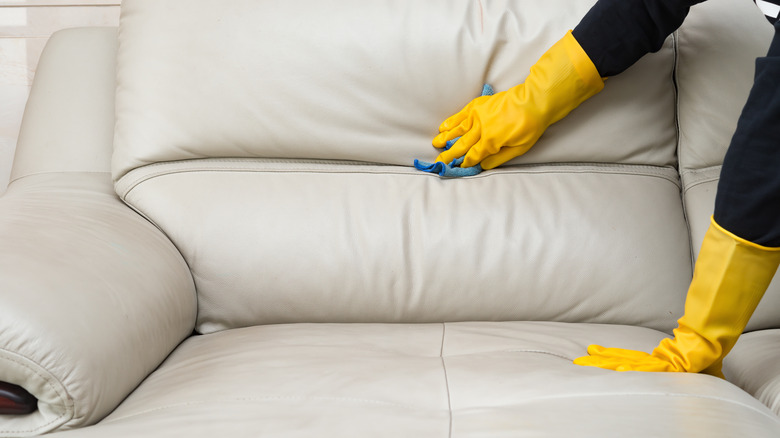Keep Your Leather Furniture Soft And Supple With This Natural Ingredient
Furnishing your home with leather pieces is both trendy and classic. The colors and style may change, but leather adds a simple yet elegant mood to any room. In order to maintain its inviting aesthetic, it's important to take care of your leather furniture, which will also aid its durability and longevity. Since leather is made from a natural material, it's vulnerable to damage from a number of things such as sunlight and moisture. Everyday wear and tear can also impact its appearance, sometimes leading to cracks, fading, discoloration, and scratches. Consequently, investing in a leather cleaner and polish is important for its upkeep and will help ensure your prized pieces last for many years to come. One way you can do this is by moisturizing your leather furniture with all-natural vegetable glycerin.
If you've never heard of vegetable glycerin, you'd be surprised to know it's a common ingredient in many of your skincare products. Derived from plant oils, it's often used for moisturizing and will help to keep your leather furniture soft and supple, resistant to cracking or drying out. Unlike some other leather cleaners or polish, vegetable glycerin is non-toxic and gentle, freeing you of any worries about skin contact. The reason it works so well on leather furniture is that it helps to maintain the natural oils already present in the leather, preventing it from becoming stiff or brittle over time. Using it from time to time will help to maintain the luxury of your leather items.
Using vegetable glycerin on leather furniture
If you're ready to give vegetable glycerin a shot to restore the soft, glossy shine to your leather furniture, start by picking up a bottle at your local hardware or grocery store, or even online on Amazon. Most bottles listed on Amazon cost about $10 or less, so it's an affordable investment to preserve the aesthetic of your furniture. Before applying the glycerin to your furniture, though, it's important to be sure it's clean. You can either use a microfiber cloth, a vacuum with a soft bristle attachment, or a damp cloth to gently wipe any dust, dirt, or residue from the surface of the leather. Then be sure it's dry before adding the glycerin.
After you've cleaned your leather, depending on the type of glycerin you purchase, you may be able to spray it directly onto the furniture or pour some onto a clean cloth to apply it manually. Don't over-saturate the leather, though, as this will cause the surface to become oily or sticky. Using the cloth, carefully massage the glycerin into the leather in circular motions, paying attention to areas that may dry out more quickly like armrests or seat cushions. Allow the product to seep into the leather for a few minutes, then use another clean, dry cloth to buff away any excess product from the surface to maintain an even application and prevent sticky residue from forming. Repeat the conditioning process twice a year for best results.
Cautions for using this method
While using vegetable glycerin to maintain your leather furniture is often a safe and eco-friendly method, there are some precautions you should keep in mind when using this type of product. When using a cleaning or polishing product, it's always a good idea to perform a spot test in an inconspicuous area before applying the glycerin to the entire surface. It would be awful to use the product on your entire sofa and then realize that it's discolored the leather. Read the manufacturer's instructions or user reviews to see if it's compatible with your furniture and what other results you can expect.
One drawback of using this product is that it's easy to over-apply glycerin to your leather pieces. Doing so leads to a greasy or sticky surface which can inadvertently attract dust and dirt, ultimately negating the use of the glycerin in the first place. If you notice you've applied too much, use a clean cloth to blot or buff away any excess. Failing to do so can compromise the appearance of your furniture and potentially stain your clothes with oil if you sit on or against it.
Finally, conditioning your leather with glycerin may not be appropriate for all types of leather. If you have specialty leather like suede or nubuck, you should consult your care instructions before proceeding with this method. These types of leather may react differently to glycerin and could potentially be ruined if you apply it improperly.


